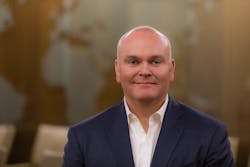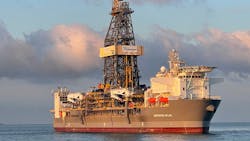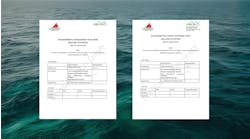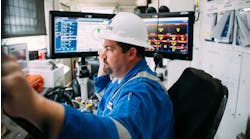Editor's note: This story first appeared in the November-December 2022 issue of Offshore magazine's first annual Offshore Oil and Gas Executive Perspectives Special Report.
By Ariana Hurtado, Editor and Director of Special Reports
Transocean has been making headlines recently for securing multiple drilling contracts worth upward of a billion dollars. In mid-October the company issued a quarterly fleet status report that listed an aggregate incremental backlog of offshore drilling rig contracts worth about $1.6 billion. A month earlier Transocean announced one of its ultradeepwater drillships had received two contracts in the Gulf of Mexico that added $181 million in firm backlog.
On the tech side, Transocean and NOV partnered on new crane technology with the aim to reduce load sway and enable crane operators to rotate loads 360 degrees. The anti-sway rotator became available for install on all Transocean rigs with knuckle boom cranes this past summer.
Moreover, earlier this year, the company made headlines again when it purchased a minority interest in Ocean Minerals Ltd. and announced its plans to invest in seabed minerals exploration.
CEO Jeremy Thigpen told Offshore, “The future of our business is very bright, and we expect offshore drilling to comprise the majority of value for our investors for the foreseeable future. Wherever possible, we will utilize our numerous competencies, assets and talented employees to undertake initiatives that support a lower-carbon future.”
Thigpen joined Transocean as CEO in 2015, and he served as president until February 2022. Prior to this role, he served as NOV’s senior vice president and CFO, spending 18 years with that company. This year the International Association of Drilling Contractors elected him to serve as its chair.
Thigpen recently shared his insights with Offshore about the energy transformation, Transocean’s emissions reduction initiatives, CCS, new technologies, rig trends and more.
OFFSHORE: How are offshore drilling operations being impacted by ESG policies, environmental assessments and/or recent regulations?THIGPEN: It is important to recognize that oil and gas have been, and will remain for the foreseeable future, the most reliable, affordable and transportable sources of energy in the world. In fact, despite all of the rhetoric around the eventual obsolescence of hydrocarbons through the ‘energy transition,’ we firmly believe that the world will continue to require oil and gas, and that the so-called ‘energy transition’ is really an ‘energy expansion,’ as our global population continues to grow, and more people will want access to reliable and affordable energy to enable a higher standard of living.
Misunderstanding how much the world depends on oil and gas leads to irresponsible (or ill-advised) regulation, unnecessary bureaucracy and funding deficits for energy companies. The effects are apparent, and they result not only in the supply/demand imbalance—leading to higher prices at the pump—but also impede investment in, and deployment of, technologies needed to achieve meaningful carbon footprint reductions.
To reduce our global carbon footprint, which we are committed to achieving, we collectively need to develop and deploy all energy sources and technologies, without ideological bias. We need energy sources in solar, wind, natural gas, hydro, oil and nuclear, or we will be pulled into energy crisis after energy crisis, at an ever-increasing cost to the global population, our economies and our security.
OFFSHORE: In October 2021, Transocean committed to reducing greenhouse-gas (GHG) emissions by 40% by 2030. Can you talk about how Transocean is moving toward this target?THIGPEN: To achieve our Scope 1 and Scope 2 GHG reduction target of 40% by 2030, we will continue to invest in the development and implementation of new technologies and other initiatives to reduce fuel consumption and optimize our power management capabilities. While achieving this goal will not be easy and progress will not be linear, we expect to make significant improvements in this area.
We are reducing the total amount of power our rigs need to generate by optimizing the energy efficiency of our equipment, reducing unnecessary power draw from inactive equipment, and developing enhanced operational guidelines that reduce power demand while maintaining safe operations. Additionally, we have recently introduced fuel additives to a few of our assets, which are further reducing our fuel consumption.
Fostering energy efficiency practices across Transocean also is important. For instance, a modern drillship has more than 5,000 light fixtures, consuming in excess of 5,000 MWh of energy annually. By converting fluorescents to LED fixtures, we believe we can save up to 68% of the power previously allocated to lighting.
OFFSHORE: In what operational offshore areas has Transocean employed digital solutions, and how would you describe the results to date?THIGPEN: Investment in new technologies is necessary if our industry is to provide more energy with fewer emissions.
At Transocean, we continue to invest in and deploy new technologies to support safer, more reliable and more efficient operations. Our initiatives include additional installations of our Smart Equipment Analytics (SEA) system and our HaloGuard personnel safety system. SEA supports our reliability performance and power optimization by providing real-time data to our teams, enabling immediate evaluation of equipment and system performance and optimization of our power generation and consumption requirements. SEA is now operational on 23 of our active rigs.
Using machine vision and wearable, real-time location transmitting technology, interfaced with drill floor machine controls, our HaloGuard system provides an advanced layer of protection for our offshore personnel by eliminating the risk of personnel being contacted by moving drill floor equipment. HaloGuard is now installed on five rigs.
OFFSHORE: What role can drilling rig contractors play in the emerging carbon capture and subsea storage market?
THIGPEN: Our experience and expertise are valuable in the carbon capture and storage market and the value offshore drillers, such as Transocean, bring is recognized by operators.
As part of our current drilling contract with Equinor, the Transocean Enabler drilled one carbon injection well and a sidetrack for another carbon injection well drilled in 2020 in support of the Northern Lights Carbon Capture Storage Project. This project enabled us to utilize our rigs and core competencies to support renewable and alternative energy projects. The Northern Lights project aims to mitigate emissions and remove carbon dioxide from the atmosphere and builds on more than 23 years of safe carbon dioxide storage on the Norwegian Continental Shelf.
OFFSHORE: What are your thoughts about the worldwide rig supply equation—the balance of rigs being constructed versus rigs retired versus rigs cold-stacked?THIGPEN: The rig supply imbalance certainly has improved in recent years, and we have done our part through rig retirements. We continue to actively manage our portfolio of high-specification floating rigs to fit the best combination of rate and term. We will not reactivate an asset if it does not fit within our broader strategy, including generating an appropriate return on the full cost of reactivation. We will continue to evaluate opportunities for our stacked fleet on a case-by-case basis and will mobilize these rigs if and when it makes sense in light of market conditions, and if we are convinced it will enhance shareholder value.
When it comes to newbuilds, the Deepwater Atlas was delivered from the shipyard this summer and commenced operations on her maiden contract this fall in the US Gulf of Mexico. And we are on pace to accept delivery of the Deepwater Titan before the year is out. Both of these rigs are backed by multi-year firm contracts and are the world’s first eighth-generation ultradeepwater drillships, featuring 3-million-pound hookload and designed for 20,000-psi well construction.
OFFSHORE: What types of offshore rigs are most in demand these days, and in what regions?THIGPEN: The outlook for our industry-leading harsh environment and ultradeepwater assets and services is the most promising it has been in many years. We expect the Gulf of Mexico to remain tight through the end of the year, and substantial contracting activity is ongoing in Latin and South America. There are 10 opportunities comprising in excess of 21 rig-years of demand in Brazil alone. And we expect more than 20 programs to be awarded and commence in West Africa and the Mediterranean within the next 18 months. Demand is expected to increase in India and Australia, and in Norway a sizeable uptick in sanctioning and contracting is anticipated by year-end.
All indications point to a further tightening of the market as we continue to see increasingly healthy day rates posted across all regions, as well as longer terms.
OFFSHORE: Has Transocean deployed any automated offshore drilling systems?THIGPEN: We’ve installed robotic riser bolting on two of our rigs to automate all activities around the rotary table during riser run and retrieval operations. This technology improves personnel safety by automating activities around the rotary table during riser operations, which improves the safety of the operation for our personnel and ultimately improves the consistency and efficiency of our operations. We have installed this system on two rigs in the US Gulf of Mexico and are currently working to outfit a third rig in the coming quarters.
OFFSHORE: What future does Transocean see in the deepsea mining market?THIGPEN: Transocean has acquired a minority interest in Ocean Minerals Ltd., a company engaged in the exploration of seabed resources containing metals critical to the growing renewable energy market. Through its affiliate, Moana Minerals Ltd., Ocean Minerals was awarded a license by the Cook Islands Seabed Minerals Authority for the exploration of polymetallic nodules within the Cook Islands Exclusive Economic Zone.
Transocean is working with Ocean Minerals on the technology and services required to collect nodules from the seabed upon receipt of a production license. The technical challenges associated with the efficient recovery of deepsea polymetallic nodules represent an opportunity for Transocean to leverage our unique offshore expertise to support the rapidly emerging energy storage market and contribute to a lower carbon energy economy.







